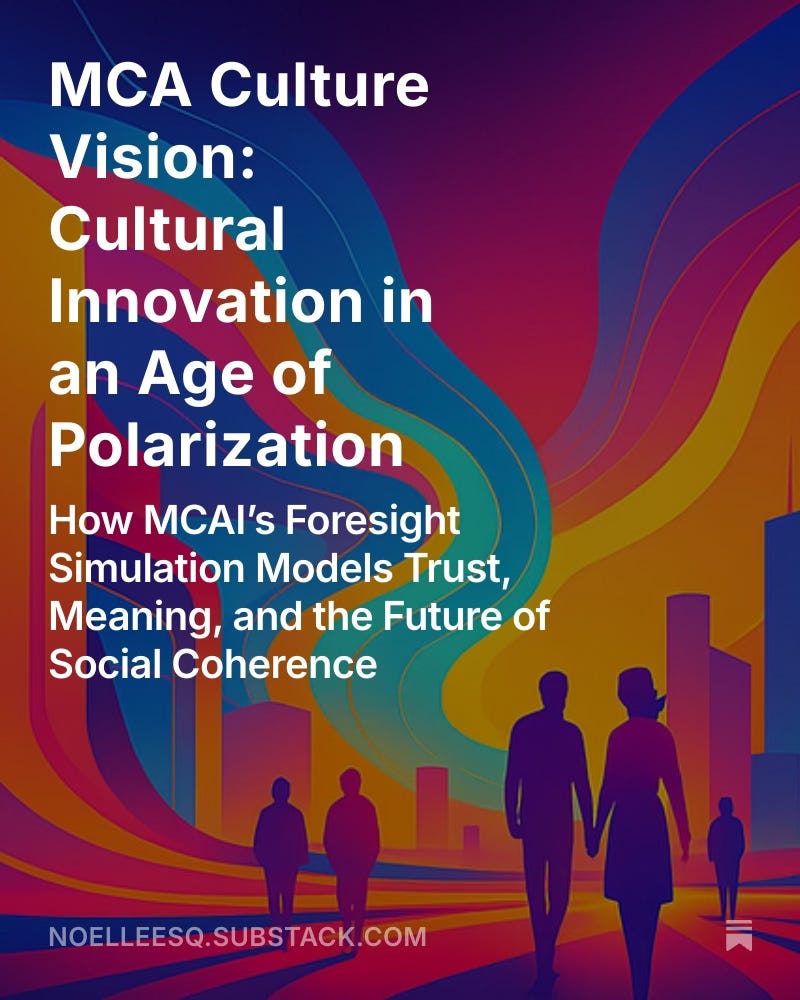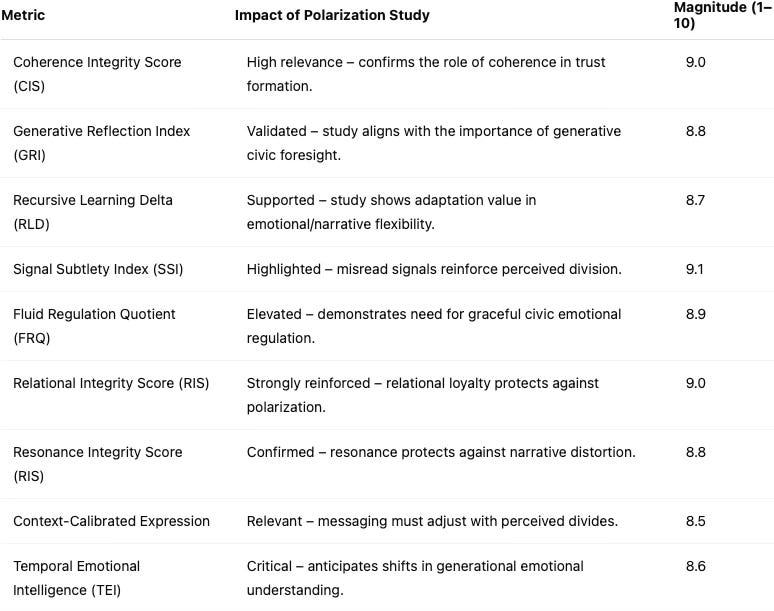MCAI Culture Vision: Cultural Innovation in an Age of Polarization
How MCAI’s Foresight Simulation Models Trust, Meaning, and the Future of Social Coherence
I. The Illusion of Division
We live in a time where society feels deeply divided. News headlines report rising polarization. Social media paints the world in red and blue, right and left, us and them. but much of this division may be exaggerated—a distortion shaped by echo chambers, insular communities, and self-reinforcing stories.
A recent study confirms what many sense but struggle to articulate: when agreement dominates our inner circles, we begin to perceive society as more divided than it truly is. This insight comes from research published in PNAS Nexus and reported by Eliza Muto in her article, Perception or Reality? Rethinking How Polarized We Really Are, Neuroscience News, (July 2025). The study shows that subjective perceptions of polarization often stem from narrow social consensus, not widespread disagreement.
MindCast AI (MCAI) sees this not as a fleeting issue, but as a deeper crisis of cultural imagination. Shrinking perception signals a breakdown in how society models itself. Repair begins not with louder arguments, but with reimagining how people see, feel, relate, and reason together.
MCAI contributes something rare: a foresight simulation system that goes beyond describing the present. It models evolving patterns of perception, trust, and narrative coherence—allowing society to anticipate breakdowns and re-align before fragmentation sets in.
II. What is MCAI Culture Vision?
Culture Vision falls within MCAI’s Cultural Innovation vertical, and is MCAI's intelligence function for understanding how meaning flows across a population. It asks: What matters? Whom do we trust? Which stories move society forward, and which ones reinforce stagnation?
Five foundations anchor this function:
Coherence Over Time: Do beliefs, emotions, and actions remain aligned across timeframes—days, years, generations?
Emotional Depth: Can we detect subtle emotional signals and remain open across disagreement?
Narrative Integrity: Do personal and public stories hold under pressure, or collapse into blame and oversimplification?
Relational Presence: Do people show up in communities with care and authenticity, online and offline?
Moral Architecture: Are actions grounded in principle, or shaped by social conformity and group protection?
These dimensions are not abstract. MCAI measures and simulates them within a living model. Culture Vision offers a structured lens into not only what is happening, but what will likely emerge next—and how people and institutions can respond with clarity.
III. Metric Validation Through Polarization Research
The polarization study significantly impacts several key metrics within MCAI’s Cultural Innovation Index framework. These include:
Coherence Integrity Score (CIS) – highlights the role of long-term alignment in reducing perception gaps.
Signal Subtlety Index (SSI) and Fluid Regulation Quotient (FRQ) – confirm the need for emotional nuance and composure to prevent polarization.
Generative Reflection Index (GRI) and Recursive Learning Delta (RLD) – underscore the importance of adaptive civic thinking.
Relational and Resonance Integrity Scores (RIS) – emphasize how social bonds and symbolic alignment buffer against fragmentation.
Temporal Emotional Intelligence (TEI) – validates the predictive role of intergenerational emotional perception.
see example of full MCAI Innovation Index: BellevueAI Driving Cultural Innovation
The following chart and table summarize how the polarization study impacts key Cultural Vision metrics used by MCAI to simulate coherence:
Table: Cultural Vision Metric Impact Assessment
IV. What the Polarization Study Reveals
The study validates what MCAI simulations forecasted: consensus within like-minded groups can distort how outsiders are perceived. This distortion forms a self-reinforcing loop.
We model this pattern as a perception–identity feedback loop:
Group consensus narrows internal discourse
Narrow discourse exaggerates perceptions of external extremism
Heightened perception hardens group identity
Reinforced identity inflames conflict with others
Left unchecked, this cycle fragments cultural resilience and democratic trust. But the simulations show it can be interrupted. Communities that expand their emotional and narrative range—through deeper listening, better questions, and clearer internal diversity—begin to restore coherence.
The outcome is not forced agreement, but trust grounded in more accurate signal interpretation.
V. MCAI’s Simulation Engine – Modeling Cultural Futures
MCAI’s core system employs Cognitive Digital Twins—intelligent representations of individuals, groups, and institutions—to simulate how trust, perception, and behavior evolve amid stress or transition.
In the context of polarization, the simulation process involves:
Signal Ingestion: Scanning discourse, emotional tone, and consensus shifts
Distortion Mapping: Identifying gaps between perception and observable reality
Trust Trajectory Forecasting: Modeling the paths and velocity of trust erosion
Narrative Stress Testing: Assessing whether cultural stories remain stable or begin to unravel
Relational Ripple Effects: Projecting shifts through schools, media ecosystems, families, and governance structures
This approach enables structured anticipation. MCAI builds testbeds for future conditions, pinpointing where trust weakens and where restoration efforts might succeed.
VI. Cultural Innovation Through Simulation
Cultural innovation depends on evolving meaning and moral clarity faster than division spreads. That evolution requires structural foresight.
MCAI enables institutions to:
Recognize when emotional unity morphs into groupthink
Detect stories approaching narrative collapse
Reinforce relational zones before external shocks destabilize them
Design reflective interventions that elevate discourse and resilience
This is not AI for prediction alone. It is foresight applied to trust design. Every system facing public accountability—from courts to universities—benefits from modeling how perception evolves before judgment calcifies.
VII. From Division to Design
Polarization emerges when cultural coherence fails to adapt. Yet coherence can be designed—if institutions commit to anticipating what lies ahead.
Culture Vision simulates not only breakdowns, but pathways toward recovery. MCAI empowers leaders and communities to:
Detect and respond to early-stage fragmentation
Defend interpretive complexity
Reinforce principled trust frameworks
Promote mutual recognition without requiring uniformity
Healing across a population requires more than time—it demands intention, structure, and foresight. Coherence must be designed, not hoped for. MCAI supplies the scaffolding to support that design.
Culture Vision equips society to perceive where it stands—and simulate where it could go.
When communities can simulate their own coherence, they unlock the tools to strengthen both systems and shared humanity.
This is the work of foresight simulation: revealing what could emerge—and guiding how we prepare.




